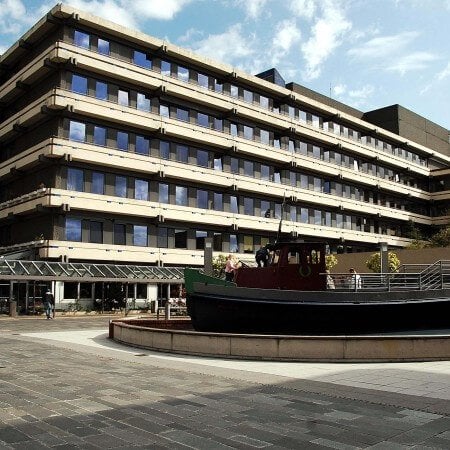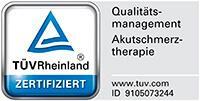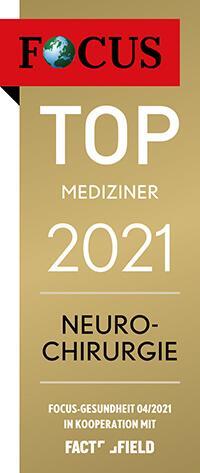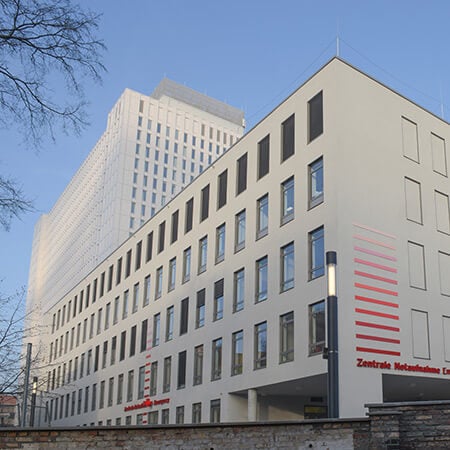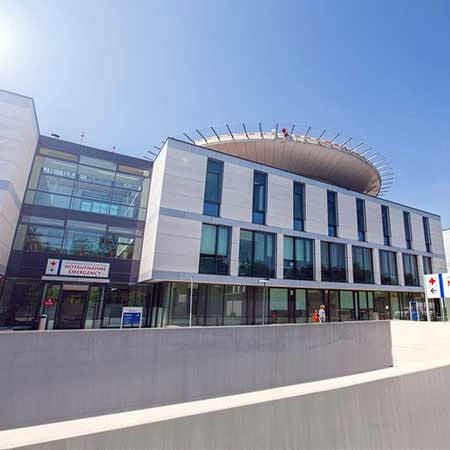Arteriovenous malformations (AVMs) are cerebrovascular disorders. These are formations, which are a "tangle" of arteries and veins. Pathology is rare, but it is dangerous: it causes hemorrhagic stroke, seizures, focal neurological symptoms. Sometimes brain AVMs can be detected even before the onset of symptoms. In such cases, doctors eliminate this vascular mass from the bloodstream to prevent life-threatening haemorrhage.
Content
- What is Arteriovenous malformation
- Are AVMs dangerous for health
- Treatment methods of Arteriovenous malformation AVM
- Endovascular treatment of Arteriovenous malformation AVM
- Radiosurgical treatment of Arteriovenous malformation AVM
- Microsurgical removal of the Arteriovenous malformation AVM
- Why is it worth undergoing treatment in Europe
- Treatment in Europe with Booking Health at an affordable price
What is Arteriovenous malformation
AVM is a "tangle" of vessels, which can enlarge over time. When these vessels rupture, cerebral hemorrhage occurs.
Typical AVM has three components:
- Tangle of blood vessels.
- Afferent arteries.
- Efferent veins.
The arteries that supply the vascular malformation expand, lengthen, and become convoluted. These changes extend to the major (large) vessels. As the arteries enlarge, blood flow increases in them. As a result, the AVM becomes enlarged, and the risk of its rupture also increases.
The number of supplying arteries varies significantly from patient to patient. Sometimes it is only one vessel, in other cases, there can be several large arteries. The more of them, and the larger the vessels, the worse the prognosis and the higher the need for treatment. Surgery to remove malformations becomes more complex: all vessels are not easy to close, while avoiding haemorrhage and ischemia (oxygen starvation) of the brain.
Are AVMs dangerous for health
Approximately 0,1% of the population has cerebral arteriovenous malformations. According to autopsy data, they are detected in 2-3% of cases. In most cases, they are minimal and do not cause any symptoms. Only 12% of people with arteriovenous malformations develop neurological symptoms.
The risk of stroke in the presence of arteriovenous malformation of the brain averages 3% per year. If a patient has already had one cerebral hemorrhage, then the probability of the second one in the first month is 15%, and then 4,5% per year.
Hemorrhagic strokes due to cerebral vascular malformations are very severe, with a mortality rate of 25%. Severe neurological deficit, which leads to disability, develops in 30% of survivors.
In the presence of the AVM, which is detected during life, the prognosis is poor. Approximately 15% of patients die within 10 years after diagnosis. The mortality rate within 30 years reaches 65%.
Treatment methods of Arteriovenous malformation AVM
There are three main treatment options for cerebral vascular malformation. These treatments are as follows:
- Microsurgical removal.
- Endovascular intervention (through the blood vessels).
- Stereotactic radiosurgery (irradiation).
In about 40% of cases, there is a need for a combination therapy. Doctors first perform an endovascular procedure, and then irradiation or resection of the malformation.
How the treatment will be carried out depends on the type of the AVM, its size, location, the patient's health condition, and the technical capabilities of the hospital. Different treatments have their own advantages and disadvantages.
Surgery is the most effective way to switch off the AVMs from the bloodstream, but it is the most traumatic one, requires long-term care and recovery, and often gives complications. Many patients have medical contraindications for surgery: pathologies of the heart, lungs, concomitant brain diseases, etc.
Endovascular medicine is attractive to many patients. The treatment procedure is minimally invasive, since the doctor performs the intervention through the vessels, but it is rarely possible to completely switch off the AVM from the bloodstream using endovascular techniques. Mostly, after an endovascular procedure, a person needs additional treatment with irradiation or surgery.
In case of brain irradiation, the patient does not feel any pain, there is no need for care and rehabilitation, complications are rare, and a high cure rate for patients is achieved. However, the effect of the procedure develops gradually, and the maximum effectiveness of radiation therapy is achieved when the AVM is up to 3 cm in size.
Endovascular treatment of Arteriovenous malformation AVM
Endovascular treatment is attractive because it is minimally invasive. The doctor obtains access to the vascular formation of the brain through an incision in the groin. He inserts a catheter into the femoral artery and advances it towards the arteriovenous malformation.
Endovascular treatment involves embolization of a vascular mass. The doctor closes its lumen, stopping the blood flow. Depending on the application specifics, embolization can be:
- Healing.
- Palliative (relieving symptoms).
- Pre-irradiation (before radiosurgical removal).
- Pre-surgical (before surgical resection of the malformation).
This type is usually determined retrospectively, namely, by the result of the procedure performed. Initially, virtually any embolization is performed as potentially curative. However, it is not always possible to completely stop blood flow in the vascular formation, so some patients require additional treatment: surgery or irradiation.
Embolization is the most common treatment for arteriovenous malformations in medicine. On average, 30% of patients can be cured without the use of other techniques. At the same time, this method is the safest and the most sparing. The procedure is performed with minimal invasion. The patient does not need to recover for a long time. The risk of neurological complications is very low.
Here are some of the favorable factors, in the presence of which the probability of cure by the endovascular method is maximum:
- Diameter of arteriovenous malformation up to 3 cm.
- Minimum afferents (supplying arteries).
- Superficial location of arteriovenous malformation.
- Location away from functionally important brain areas.
In the absence of these factors, embolization is not performed or is considered as a preparation for other treatment methods.
It is technically possible to perform embolization of the arteriovenous malformations of any size. However, the smaller it is, the higher the probability of complete exclusion from the bloodstream.
Doctors use different methods for embolization: fast-hardening adhesive or non-adhesive compositions, and microcoils. The choice depends on the type of malformation and its size. A combination of several techniques is possible. To prevent the migration of microcoils into the venous bed, doctors pre-implant stents in the afferent arteries.
Ideally, total AVM obliteration is thу result of the endovascular treatment. If this is not possible, then the arteriovenous malformation decreases in size, the most dangerous AVM areas in terms of rupture and the development of stroke are excluded. To completely exclude it, further irradiation or surgery is performed, which becomes safer for health after preliminary endovascular treatment.
Radiosurgical treatment of Arteriovenous malformation AVM
The essence of radiosurgical treatment is to irradiate the brain area where the arteriovenous malformation is located. The vessels are damaged, blood flow through them stops.
Such a therapy is carried out in countries with developed medicine. It requires modern equipment, namely Gamma Knife or CyberKnife systems. The technique is very effective. With the irradiation of arteriovenous malformations up to 3 cm in diameter, total cessation of blood flow is observed in 95% of cases, and in AVMs over 3 cm, the effectiveness of radiosurgery is 70%.
In countries with advanced medicine, proton therapy can be used instead of conventional photon irradiation. This type of procedure is safer for health. The brain tissue is less irradiated, since the protons release radiation only upon reaching the target, and not along the entire trajectory of movement.
Radiosurgery has obvious advantages. These include:
- It allows the doctors to destroy AVM of hard-to-reach localization – deep in the brain.
- There is no need for long-term recovery and care, as after surgery.
- It is possible to perform it in patients with medical contraindications for surgical intervention.
- Less risk of complications than after surgery.
- Patient adherence to treatment is better, since the AVM can be treated with radiation without pain and without any discomfort.
However, there is also a drawback: the effect develops gradually, during 2-5 years. This means that in the presence of symptoms: pain, epilepsy, etc., they do not regress immediately after irradiation. Hemorrhage is more common after irradiation than after surgery.
Microsurgical removal of the Arteriovenous malformation AVM
Microsurgical removal is a surgical procedure to physically remove an arteriovenous malformation. This is the most effective method. The cure rate is 94%, and in some specialized centers the number of successful surgeries is close to 100%. However, the method has several disadvantages. The main one is that surgery is unsafe for health.
The surgical removal has the following disadvantages:
- The highest risk of neurological complications among all methods.
- Significant trauma rate.
- Long recovery, the need for care in the first time after surgery.
Surgical resection remains the most common treatment for arteriovenous malformations in the world. This is the method of choice for patients with low surgical risk (young people with good health, absence of heart disease or other pathologies). In case of large AVMs, which have many afferent arteries, surgery is often combined with endovascular treatment, which is performed prior to surgery.
Patients need good care after surgery. Patients of the neurosurgical center undergo therapy, which is aimed at preventing hemorrhage, infections, cardiovascular and other complications. Many patients require prolonged sedation and controlled ventilation.
Why is it worth undergoing treatment in Europe
Many patients prefer to undergo treatment of brain AVMs in countries with advanced medicine. The treatment abroad is effective and safe for health. Patients are provided with high quality pain therapy, supportive therapy, care, and comprehensive neurological rehabilitation.
There are several reasons for you to undergo brain AVM treatment in one of the neurosurgical centers in developed countries:
- Preference is given to more sparing treatment methods: endovascular, radiosurgical.
- Doctors try to eliminate brain AVM using only one method, if possible.
- Successful elimination of brain AVMs of any size.
- Surgical interventions are performed with minimal health risks.
- High-precision diagnostics, including intraoperative diagnostics, allows the doctors to detect functionally important brain areas so as not to damage them during treatment.
- After the operation, patients are provided with high quality care, symptomatic therapy and rehabilitation.
The timely treatment of AVM in the neurosurgical center will help you avoid a stroke and maintain health. You will be treated by specialists from one of the best hospitals in the world, so you can count on the complete elimination of arteriovenous malformation and the disappearance of all symptoms of pathology.
Treatment in Europe with Booking Health at an affordable price
To undergo treatment for arteriovenous malformations in one of the European hospitals, please use the services of Booking Health. On our website, you can see the cost of treatment in different hospitals, compare prices and book a medical care program at an affordable price. The treatment of arteriovenous malformation in a European hospital will be easier and faster for you, and the cost of treatment will be lower.
Please leave your request on the Booking Health website. Our employee will contact you and provide consultation about treatment in Europe. The medical tourism company Booking Health will take care of the organization of your trip. We will provide the following benefits for you:
- We will select a hospital for treatment in Europe, whose doctors specialize in the treatment of arteriovenous malformation.
- We will help to overcome the language barrier, establish communication with the employees of the medical facility.
- We will reduce the waiting period for the medical care program and book a doctor's appointment on the most suitable dates.
- We will reduce the price. The cost of treatment in European hospitals will be decreased due to the lack of additional coefficients for foreign patients.
- We will take care of all organizational issues: documents for entering the country, transfer from the airport, hotel, interpreting services, etc.
- We will prepare a medical care program and translate medical records. You do not have to undergo previously performed diagnostic procedures.
- We will provide communication with the hospital after treatment in Europe.
- We will organize additional examinations and treatment in European hospitals, if necessary.
- We will buy medicines abroad and forward them to your native country.
- We will help you keep in touch with the hospital and the attending physician after treatment in Europe.
You will receive treatment from the best doctors in the world. The Booking Health specialists will help you reduce the cost of treatment and take care of all organizational issues, and you will only have to focus on restoring your health.
Authors:
The article was edited by medical experts, board-certified doctors Dr. Nadezhda Ivanisova and Dr. Vadim Zhiliuk. For the treatment of the conditions referred to in the article, you must consult a doctor; the information in the article is not intended for self-medication!
Sources:
National Center for Biotechnology
Medical News Today
Journal of Neurology, Neurosurgery and Psychiatry
